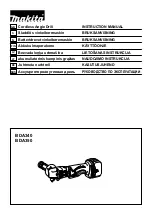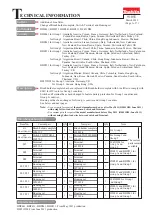
7. Strombegrenzung und Fusemode
Das SNT140-K kann über den 7-poligen Stecker (Pins
4 und 6) in zwei Betriebsarten benutzt werden.
Strombegrenzung
(Pin6 offen):
Über die Regelung des Potentiometers können Sie die
max. Stromstärke (0,5-1,2xI
) festlegen, an der das
nenn
Gerät die Last trennt und die Meldung über das Relais
erfolgt.
Dabei steht eine Leistung über 100% dem Anwender
nur für eine begrenzte Zeit zur Verfügung. Die Zeit ist
abhängig von der Höhe der
(siehe Diagramm
Leistung
unten). Nach Ablauf dieser Zeit trennt das Gerät für ca.
50 Sek. die Last und schaltet diese anschließend
wieder automatisch zu.
Zur
Einstellung der Stromgrenze
drehen Sie das
Potentiometer (Einstellung Stromgrenze) auf den
größtmöglichen Wert (im Urzeigersinn).
Stellen Sie die Last auf den Wert ein, an dem das
Netzteil die Last trennen soll.
Drehen Sie anschließend das Potentiometer zurück,
bis die Last getrennt wird.
Fuse-Mode
(Pin4 und 6 gebrückt):
Durch eine Brücke zwischen Pin 4 und 6 wird die
elektronischen Sicherung (Fuse-Mode) aktiviert.
Die “Sicherung” löst aus:
wenn
die von Ihnen eingestellte Strombegrenzung,
oder
die zeitliche Begrenzung der Last (siehe
Diagramm) überschritten wird.
Bei Fuse-Mode schaltet das Gerät die Last sofort ab
und geht in
Standby
. Ein Neustart ist erst nach
manuellem Reset möglich.
7. Current-Limiting and Fusemode
The SNT140-K can be used in two different modes by
using the 7-pin plug (Pins 4 and 6) and the
potentiometer (Current limit).
Current limit
(Pin6 open):
With the regulation of the potentiometer you can set up
the current (0.5-1.2xI
) on which the device limiter tilts
nom
and the message “overload” on relay 2 is displayed.
A performance more than 100% is only available for a
limited time. The time depends on the level (see
diagram below). After this time the device disconnects
the load for approx. 50 seconds and then switches it
on again automatically.
To
set the current limit,
turn the potentiometer
(Adjustment Current limit) to the highest possible
value (clockwise).
Set the load of your device to the value at which the
power supply should disconnect the load.
Then turn the potentiometer back until the load is
disconnected.
Fuse-Mode
(Pin4 and 6 bridged)
A bridge between pins 4 and 6 activates the electronic
fuse (fuse mode).
The „fuse“ triggers:
if
the current limit,
or
the time limit of the load (see diagram) is exceeded.
In fuse mode, the device switches off the load
immediately and goes into standby. A restart is only
possible after a manual reset.
Überlastverhalten
Over-Load-characteristic
80%
100%
110%
Ausgangsstrom Output Current
1
2
4
5
6
Zeit / Time (min.)
Betriebsbereich / Operation range
120%
7
3
Der hier gezeigte Lüfter
ist ein Vorschlag zur
Anwendung bei hohen
Last- oder Temperatur-
verhältnissen.
The fan shown here is
a proposal for use in
high-load or
temperature conditions.
A manual reset is only possible after a longer cooling phase. Sufficient
cooling is indicated by a green flashing of the "Temperature" LED
(or by a yellow LED if Fusemode was previously activated by the customer).
Ein manueller Reset ist erst nach einer längeren Abkühlphase möglich.
Eine ausreichende Abkühlung wird durch ein grünes Blinken der LED
"Temperatur" angezeigt (oder durch eine gelbe LED, wenn Fusemode
durch den Kunden zuvor aktiviert war).
Übertemperatur erreicht - Over-Temperature is reached
To indicate the error
, the
temperature LED
is
red
and
the
output LED
f
lashes red
.
After cooling down, the
LED
temperature flashes green
again.
Attention:
If
Fusemode
was
set before, the
temperature
LED is yellow
after cooling
down.
Sollte die Gerätetemperatur auf über
85°C
steigen,
öffnet Temperatur Relais 1-3, die interne Schutz-
schaltung schaltet automatisch die Last ab, das
Gerät wechselt automatisch intern in FuseMode und
geht in Standby.
Nach dem Abkühlen
ist ein
manueller Reset
nötig:
1. Kontakte 4-6 für 3 Sekunden kurzschließen
und
danach wieder öffnen. (Damit wird der automatisch
intern gesetzte FuseMode deaktiviert.)
2. Kontakte 4-5 für 3 Sekunden kurzschließen
und
danach wieder öffnen. (Eigentliches Reset)
Die Last wird automatisch wieder freigeschaltet.
Das Relais 1-3 schließt wieder.
3. Bei Bedarf FuseMode
wieder durch Brücke
zwischen
Kontakten 4-6
aktivieren.
If the device temperature rises above
85°C
,
temperature relay 1-3 opens, the internal protection
automatically switches off the load, the device
automatically changes internally to FuseMode and
goes into standby.
After cooling down,
a
manual reset
is necessary:
1. Connect contacts 4-6 for 3 seconds
and then
disconnect them. (This deactivates the
automatically internally set FuseMode)
2. Connect contacts 4-5 for 3 seconds
and then
disconnect them. (Actual reset)
The load is automatically enabled again.
3. If desired, reactivate FuseMode
by bridging
contacts 4-6
.
Zur
Anzeige des Fehlers
leuchtet die LED
Temperatur
rot
und LED
Ausgang blinkt
rot
.
Nach dem Abkühlen
blinkt die
Temperaturanzeige wieder grün.
Achtung:
Wenn zuvor
Fusemode
eingestellt war,
leuchtet die
Temperatur LED
danach
gelb.
U
out
+
- Verbraucher
consumer
Lüfter
Fan
Relais
Relay
N
L1
interne Relais-Belegung
internal relays assignment
SNT140-K
1
2
3
Kontakt 3
contact 3
























